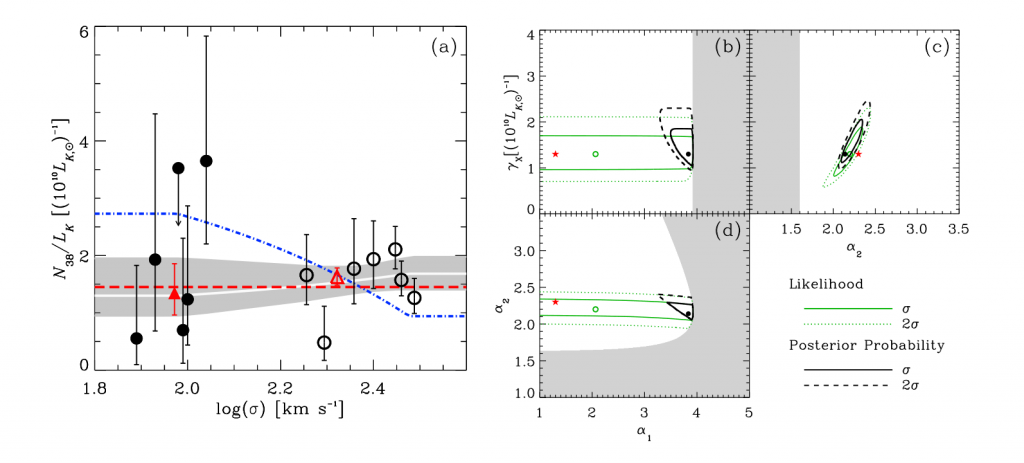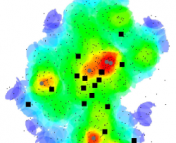Title: Testing the Universality of the Stellar IMF with Chandra and HST
Authors: D.A. Coulter, B.D. Lehmer, R.T. Eufrasio, A. Kundu, T. Maccarone, M. Peacock, A.E. Hornschemeier, A. Basu-Zych, A.H. Gonzalez, C. Maraston, and S.E. Zepf
First Author’s Institution: University of California Santa Cruz, Santa Cruz
Status: Accepted for publication in the Astrophysical Journal, open access
Introduction
It is said that the flame that burns twice as bright burns half as long. Lao Tzu might have been pleased to know that his aphorism is approximately true in stellar astrophysics, where a star twice as bright as the sun lives for about 62% as long before burning out.
In aging galaxies this presents us with a problem. To truly understand the galaxy we need to understand the stars comprising it, yet in those galaxies which aren’t actively manufacturing stars, most of the biggest, brightest stars are already dead. We know, however, that during their short lives they have a profound effect on their host galaxies. The largest stars shine brightly enough to help drive galactic winds which can expel gas from a galaxy. At the end of their lives these stars explode as supernovae, events in which heavy elements are created and scattered far and wide. Supernovae leave behind either a dense neutron star, or, in the case of the most massive stars of all, a black hole (more details here).
All this is actually somewhat irksome, because black holes – as the name suggests – are completely dark, making it rather difficult to find out anything about them, or indeed their progenitors, the short-lived giant stars. On the other hand, there are good reasons to be interested in galaxies which have ceased to make new stars. The most massive galaxies in the universe typically formed their stars very swiftly before shutting down for good billions of years ago. There are consequences to this extreme star formation: in particular, these galaxies seem to form more low-mass dwarf stars than we’d expect from observing nearby star formation. Put another way, the initial mass function (which describes how many stars of a particular mass you end up with when a gas cloud collapses to form stars) may be different in these galaxies than in our own Milky Way.
That result raises a critical question. If massive galaxies are forming excess dwarf stars, does that mean they have a dearth of giant stars? This isn’t necessarily the case: since all the giant stars are dead and gone, most of the light from these galaxies is coming from medium, roughly sun-sized stars. If what we’re seeing is actually a shortage of these stars relative to other types, that would mean relatively more dwarf and giant stars by comparison. Massive stars are responsible for much of the chemical enrichment of a galaxy, through supernovae – and massive galaxies are very chemically enriched, which could be challenging to explain if they are short on giant stars. Today’s paper aims to settle the matter.
Today’s paper
The paper we’re featuring today is actually a follow-up to some work which was done two years ago, which we featured at the time. To give you the gist, because stars like to form in binary systems, dying in a supernova explosion is not quite the end of the story for many black holes and neutrons stars. A black hole in a binary system can end up consuming its companion, giving it a new lease of life as a low-mass X-ray binary (LMXB). As gas from the low-mass companion star falls onto the black hole, the immense acceleration causes it to heat up and emit high energy X-ray photons before finally being swallowed up. This means we can detect LMXBs even at very great distances (or at least, we can with space-based X-ray telescopes such as Chandra). The upshot is this: we can figure out how many LMXBs we expect to see (given local formation rates of giant stars in binary systems) and compare that to how many we actually see.
In that previous work the authors concluded that they could not find any evidence for variations in the number of giant stars. However, the sample of galaxies was small and focused on the most massive galaxies, leading to some uncertainty about whether other effects could explain their observations. To rectify this, the current paper adds five galaxies with lower masses to the sample and uses a souped-up statistical analysis, the results of which are shown in Figure 1. The left panel shows the ratio between the number of LMXBs and the near-infrared luminosity for each galaxy (which is proportional to the number of medium-sized stars) for the new galaxies in the study and those presented in the previous paper on this subject. The x-axis is velocity dispersion, but you can think of it as total galaxy mass. The models explored in the previous paper are shown alongside the best fitting model from the new analysis, which is summarised in the right panel of this figure. This model has three parameters – in broad strokes, the relative number of dwarf stars to medium-sized stars, the relative number of giant stars to medium-sized stars, and the fraction of black hole remnants that actually end up in LMXB systems. The contours in the right panel simply show the most likely values for these parameters (the only difference between the green ‘likelihood’ contours and the black ‘posterior probability’ contours is that the latter takes into account some additional information from work others have done).

Left panel: This shows the ratio between the number of LMXBs and the near-infrared luminosity for each galaxy for the new galaxies (black points) in the study and those presented in the previous paper on this subject (open circle). The x-axis is velocity dispersion. The dashed lines are models explored in the previous paper; the white bold line is the best model the authors find for how the quantity of LMXBs varies with galaxy mass. Right panel: the authors’ model has three parameters and the contours shown indicate the best-fitting values for those parameters (see text)
The improved study seems to bear out the results of the earlier work, finding little evidence for variation in the proportion of high mass stars between galaxies. Because such stars are so important to how galaxies develop over time, this result is important for future studies of galaxy evolution – although the authors caution that there are still some remaining uncertainties in how the formation mechanism of LMXBs may vary. It is hoped that these will be addressed in the near future.




